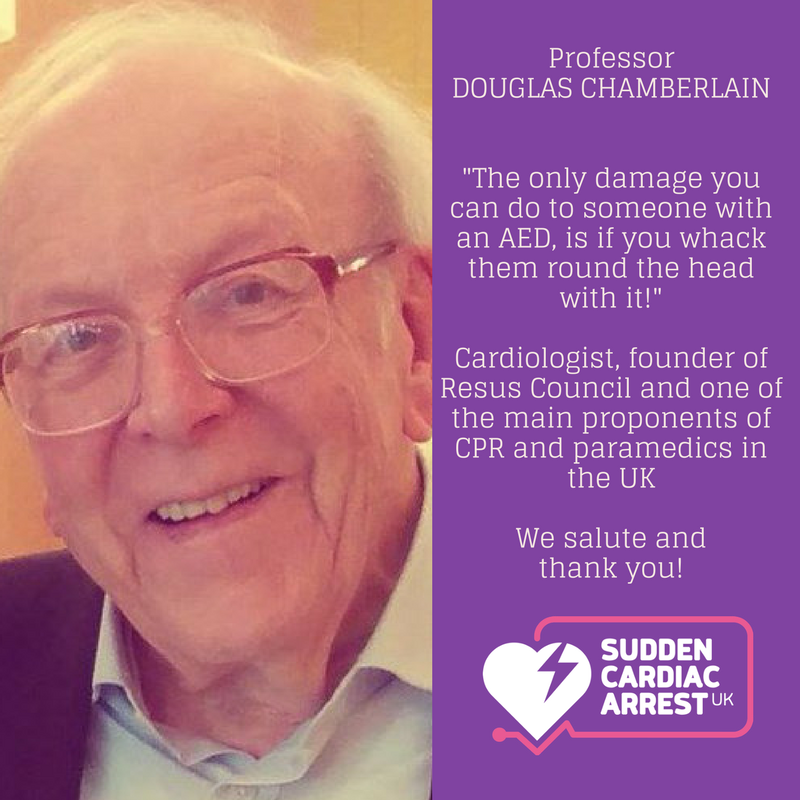Each year about 30,000 people receive resuscitation for an Out-of-Hospital Cardiac Arrest (OHCA) in the United Kingdom. Only one in every twenty people that have a cardiac arrest survive to go home from the hospital. There are a few key steps that can help to improve survival from cardiac arrest, and these have been formulated into a chain of survival;

- Prevention & early recognition
- Early CPR – cardiopulmonary resuscitation
- Early defibrillation
- Post-resuscitation care
In this post, I am going to talk about each of these steps, the impact they have on survival, and the evidence for them.
Cardiac Arrest
Cardiac arrest is when the heart stops pumping blood around the body. As the blood carries oxygen around our body, a cardiac arrest means that the body becomes starved of oxygen. The brain is the organ most immediately affected by this. When the brain stops receiving oxygen the person will immediately lose consciousness and become unresponsive. Their brain will also stop sending messages to the body telling you to breathe, so this will also stop. If this oxygen starvation continues the brain will become damaged. If sufficient damage occurs then the injury will be irreversible and the person will die.
Step 1 – Prevention & Recognition
The first part of step one is simple, if cardiac arrest can be prevented, then the patient will have a better outcome. This is in many ways the most important part of the chain of survival but is also the least directly related to cardiac arrest. There are many campaigns for the recognition of conditions which can lead to cardiac arrest, including the ‘Surviving sepsis campaign’ and campaigns from the BHF on heart attack recognition (Heart attacks are by far the commonest cause of a cardiac arrest).
Early recognition of cardiac arrest is vital because the previously described brain injury begins to occur within minutes of loss of blood flow. When you phone 999 they will start by asking you two simple questions;
‘Is the patient conscious?’
and…
‘Are they breathing normally?’
If the answer to both of these questions is no, then as explained previously, there is no blood getting to the brain because they are in cardiac arrest.
Why do they ask about ‘normal’ breathing though?
The answer is ‘agonal breathing’.
As the brain is being starved of oxygen, before someone completely stops breathing, they may make some gasping breaths. These are not enough to get oxygen to the brain and mean that the patient is in cardiac arrest. However, agonal breathing is commonly mistaken for normal breathing and so leads to delays in CPR.
And what about the pulse check that you were taught about when learnt to do CPR?
Well it is true that is someone is in cardiac arrest you wont be able to feel a pulse.
BUT, in a high-stress environment, you are very likely to be able to feel your own pulse and mistake it for theirs. This may lead to failure to recognise the cardiac arrest and delays in CPR. The study discussed in this article showed that even trained healthcare professionals are liable for making errors in pulse recognition.
Step 2 – Early CPR
So now we have called 999 and recognised the cardiac arrest, what can we do to help?
CPR – cardiopulmonary resuscitation
Early and effective CPR by ‘bystanders’ is vital to improving cardiac arrest survival. In Norway, they have achieved outstanding levels of bystander CPR. This study showed that a campaign to improve bystander CPR rates sent them up to 73% and survival rates were 22% (significantly above the UK survival rates where less than 50% of people have bystander CPR).
So we know that CPR is vital, but do I have to do chest compressions and mouth-to-mouth?
This question is particularly important at this time given the ongoing COVID-19 pandemic (see Resus Council UK website for more info on regarding CPR and COVID-19)
Well, Vinnie Jones told us a few years ago that hands-only CPR is effective. It has been shown that in those with significant training, mouth-to-mouth improves outcomes, but as the idea of mouth-to-mouth puts some people off doing anything, the message to the general public is that hands-only CPR is the way to go!
Step 3 – Early Defibrillation
Now we have started CPR, we have some oxygen getting to the brain again, but we know that this isn’t as effective as having the persons heart pumping the blood itself. The best way to get a heart started again if it has stopped is to deliver a shock (the heart can’t always be restarted with a shock, it only works if the heart is in particular abnormal rhythms). It is therefore clear that the earlier that we get a defibrillator to deliver a shock, the better the patient is likely to do. One way to do this is to get an ambulance to the patient quickly. There are many ways of trying to achieve this such as diverting ambulances from other calls and ensuring that the arrest is quickly identified in the call centre. However, can we shock the patient before the ambulance even gets there?
Well, automated external defibrillators (AEDs) are becoming increasingly commonplace. They are often located in public places like schools, sports centres and train stations. If you want to find your nearest AED you can look at our UK AED Map page.

One of the main reasons that public access AEDs are not regularly used is because people are worried about causing harm by using them. But as public access AED pioneer Professor Douglas Chamberlain CBE says in his interview on the ‘Life After Cardiac Arrest’ podcast – “The only damage you can do to someone with an AED, is if you whack them round the head with it!”
When you turn on an AED it will talk you through the process of using it and this St John’s video shows how easy it is to use.
Step 4 – Post-Resuscitation Care
There are a variety of techniques to improve outcomes once someone has been resuscitated. Some of these are well known with complex treatments on intensive care and investigation of the causes of the cardiac arrest. There are also a wide variety of methods undergoing research studies to determine whether they are beneficial such as ‘targeted temperature management’ and studies into the most effective long term follow up techniques for cardiac arrest survivors.
It is only in recent years that it has been recognised that this step may need expanding in terms of its definition as the preceding steps occur over relatively short periods of time, whereas this can be for considerably longer. Clarification will allow for greater emphasis on the post-discharge and recovery phase, and once the guidelines have caught up with the research.
So that completes our brief tour through the cardiac arrest chain of survival. There is obviously a lot of complexity to the chain of survival which we haven’t covered here and the links throughout the article are designed to direct towards reliable sources of information on these topics. For more information check out our website, the Resus Council UK, the British Heart Foundation, and for more technical guidelines, ILCOR and the ERC provide thorough evidence-based information on cardiac arrest management.
Thanks for sticking with us and get in contact if you have any questions!
Feature Image by Kranich17 from Pixabay


7.9% is the survival rate … in England
“OHCA incidence and outcome varies greatly around the globe”
https://www.sciencedirect.com/science/article/abs/pii/S0300957210004326
EMDR is a therapy for post CA – I can personally vouch for that.
Out-of-Hospital Cardiac Arrest Outcomes registry, hosted by University of Warwick, show in 2018 overall survival rate of around 9.5% (https://warwick.ac.uk/fac/sci/med/research/ctu/trials/ohcao/publications/epidemiologyreports/). Figure for 2019 will be published shortly on website. For other information about cardiac arrest in UK (only available for England at the moment) see interactive map at: https://warwick.ac.uk/fac/sci/med/research/ctu/trials/ohcao/map